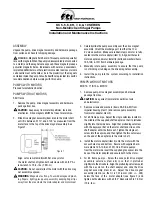
5 Installation
5.1 Setting up vacuum pump
CAUTION
Danger of burns on hot surfaces
Depending on the operating and ambient conditions, the surface temperature of the vacuum pump
can increase to above 70 °C. If access to the vacuum pump is unrestricted, there is a danger of burns
due to contact with hot surfaces.
► Install suitable touch protection if the vacuum pump is accessible to untrained persons.
► Allow the vacuum pump to cool down before carrying out any work.
► Contact Pfeiffer Vacuum for suitable touch protection in system solutions.
General notes for the installation of vacuum components
► Choose an installation location that permits access to the product and to supply lines at all times.
► Observe the ambient conditions given for the limits of use.
► Provide the highest possible level of cleanliness during assembly.
► Ensure that flange components during installation are grease-free, dust-free and dry.
Required aids
● Fastening material 4 × M12
Procedure
1. Check the carrying capacity of the floor at the installation location.
2. Ensure sufficient space under the vacuum pump for a collection receptacle when filling or chang-
ing lubricant.
3. Ensure the prescribed mounting orientation of the vacuum pump before the vacuum pump is filled
with lubricant for the first time.
4. Place the vacuum pump on a flat, horizontal and fixed surface, to safeguard the lubricant supply.
– Reference surface is the vacuum flange.
5. Screw the vacuum pump to the base without tension.
6. Maintain the minimum distances to bordering surfaces to guarantee sufficient air circulation.
7. Leave the filling/drain holes and sight glasses freely accessible.
8. Fill with lubricant prior to first commissioning.
5.2 Mounting orientations
NOTICE
Damage to the vacuum pump due to incorrect mounting orientation
Impermissible mounting orientations will result in contamination of the process vacuum or damage to
the vacuum pump.
► Operate the vacuum pump only with the permissible mounting orientation.
Installation
24/68
















































